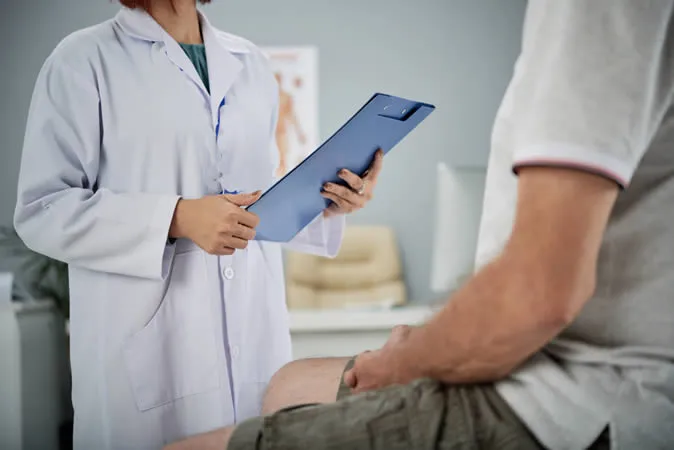What is Dermatofibromas?
A dermatofibroma is a small, harmless lump that forms in the skin, usually on the legs. It is made of fibrous tissue and may be caused by a minor injury or insect bite. It is not a sign of cancer and does not need treatment unless it causes discomfort or cosmetic concern.

What are the signs and symptoms of Dermatofibromas?
Some signs and symptoms of dermatofibromas are:
- They are small, hard, raised skin growths that usually appear on the lower legs, but may also occur on the arms or trunk.
- They are firm to the touch and may feel like a small stone under or above the skin.
- They have a round shape and a diameter of about 0.5–1.5 cm.
- They vary in color from pink to brown or black, depending on the skin tone of the person. Some may have a paler center.
- They do not usually cause any pain or discomfort, but they may sometimes be itchy, tender, or inflamed.
- They show a dimple sign when pinched, which means the overlying skin sinks in.
What are the causes of Dermatofibromas?
The exact causes of dermatofibromas are not well understood, but some possible factors that may trigger them are:
- Trauma or injury to the skin, such as a cut or scratch
- Insect or spider bites, which may introduce foreign substances or microorganisms into the skin
- Splinters, which may cause inflammation and scarring of the skin
What treatments are available at the dermatologist for Dermatofibromas?
There are different treatment methods available at the dermatologist for dermatofibromas, depending on the size, location, and appearance of the growth.
Some of the most common methods are:
- Surgical excision: This involves cutting out the entire dermatofibroma with a scalpel and stitching the wound closed. This method can completely remove the growth, but it may leave a scar and cause some bleeding or infection.
- Shave removal: This involves shaving off the top part of the dermatofibroma with a blade or a laser. This method can reduce the size and visibility of the growth, but it may not remove it completely and it may grow back over time.
- Punch removal: This involves using a circular device to punch out a small piece of skin containing the dermatofibroma and stitching the wound closed. This method can remove most of the growth, but it may leave a small scar and cause some bleeding or infection.
- Cryotherapy: This involves freezing the dermatofibroma with liquid nitrogen and causing it to fall off. This method can be effective for small and superficial growths, but it may not work for larger or deeper ones and it may cause some pain, blistering, or discoloration.
The choice of treatment depends on several factors, such as the preference of the patient and the doctor, the cost and availability of the procedure, and the potential risks and benefits of each method.

Dermoscopy of Dermatofibroma
Dermoscopy of dermatofibroma can reveal different patterns and features, depending on the color, shape, and location of the lesion. Some of the most common dermoscopic features of dermatofibroma are:
- A delicate pigment network that surrounds the lesion and fades into the normal skin. The network may be light to medium brown in color and have a fine and thin quality.
- A central white scar-like patch that occupies the center of the lesion and has an irregular shape and sharp borders. The patch may appear as a white area in non-polarized light or as bright white areas with or without shiny white lines in polarized light.
- Ring-like or donut-shaped globules that are located toward the center of the lesion and interrupt the pigment network. The globules may consist of brown pigment or blood vessels.
- A white network that consists of white lines surrounding small islands of brown pigment or ring-like globules. The white network may resemble a negative image of the pigment network.
- Vascular structures that may be present in some dermatofibromas, especially those that are inflamed or ulcerated. The most common types of vessels are dotted, comma, and hairpin vessels, but other types such as glomerular, linear-irregular, radial, and polymorphous vessels may also be seen.
What are the potential complications of Dermatofibroma removal?
Some potential complications of dermatofibroma removal are:
- Infection: This can occur if the wound is not properly cleaned and dressed after the procedure. Signs of infection include redness, swelling, pus, fever, and pain.
- Bleeding: This can happen during or after the procedure, especially if the dermatofibroma is large or deep. Bleeding can be controlled by applying pressure and bandages to the wound.
- Scarring: This is inevitable after any surgical procedure, as the skin heals by forming scar tissue. The size and appearance of the scar may depend on the location, size, and depth of the dermatofibroma, as well as the technique used to remove it. Some scars may be more noticeable or cosmetically undesirable than others.
- Recurrence: This means that the dermatofibroma grows back after removal. This can happen if some of the cells are left behind or if the cause of the growth is not addressed. Recurrence is more likely for cellular dermatofibromas, which are deeper and more aggressive than other types.
FAQ About Dermatofibromas
What do dermatofibromas look like?
Dermatofibromas can vary in color from pink to brown or black, depending on the skin tone of the person. They have a round shape and a diameter of about 0.5–1.5 cm. They are firm to the touch and may feel like a small stone under or above the skin.
Are dermatofibromas dangerous?
No, dermatofibromas are benign growths that do not pose any serious health risk. They are not a sign of cancer and do not need treatment unless they cause discomfort or cosmetic concern.
How are dermatofibromas diagnosed?
Dermatofibromas can usually be diagnosed by their appearance and the dimple sign. However, if there is any doubt or concern about the diagnosis, a skin biopsy should be performed to confirm it. A skin biopsy involves taking a small sample of the lesion and examining it under a microscope.
Is there a dermatologist near me in Madison that offers treatment for Dermatofibromas?
Yes. At our Madison dermatology office we offer treatment for Dermatofibromas to patients from Madison and the surrounding area. Contact our office today to schedule an appointment.

